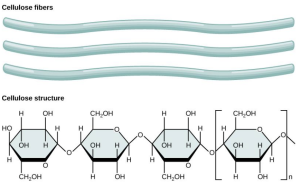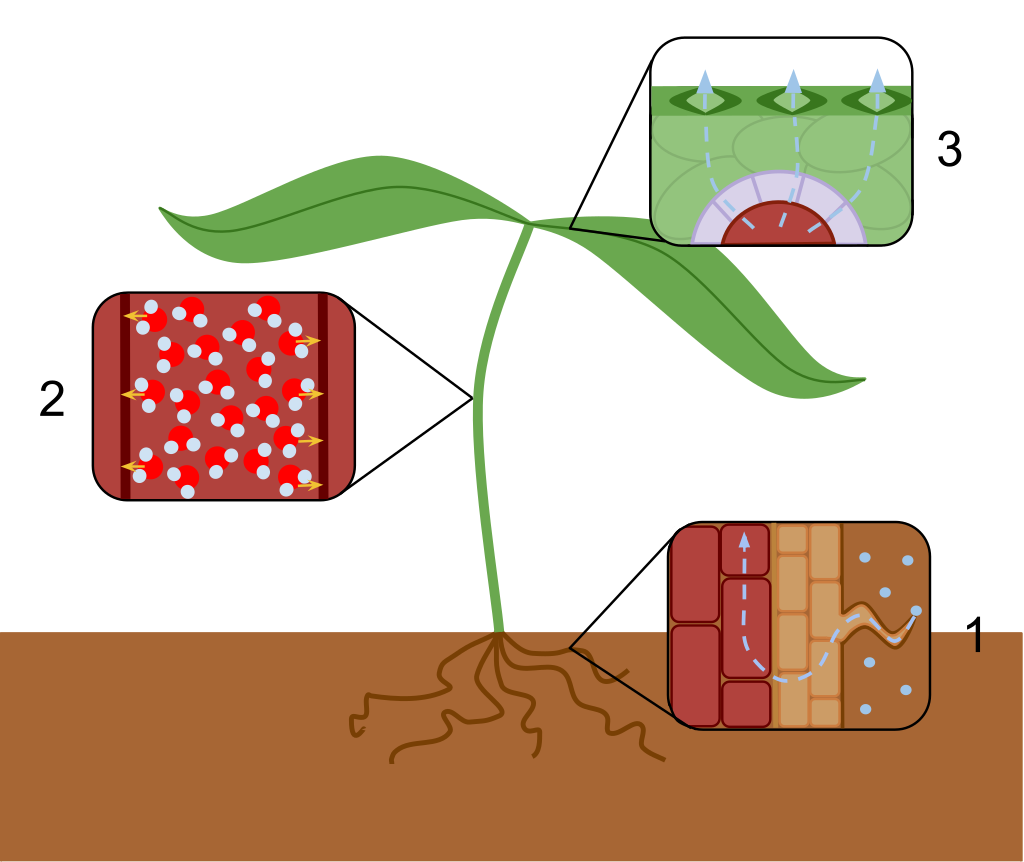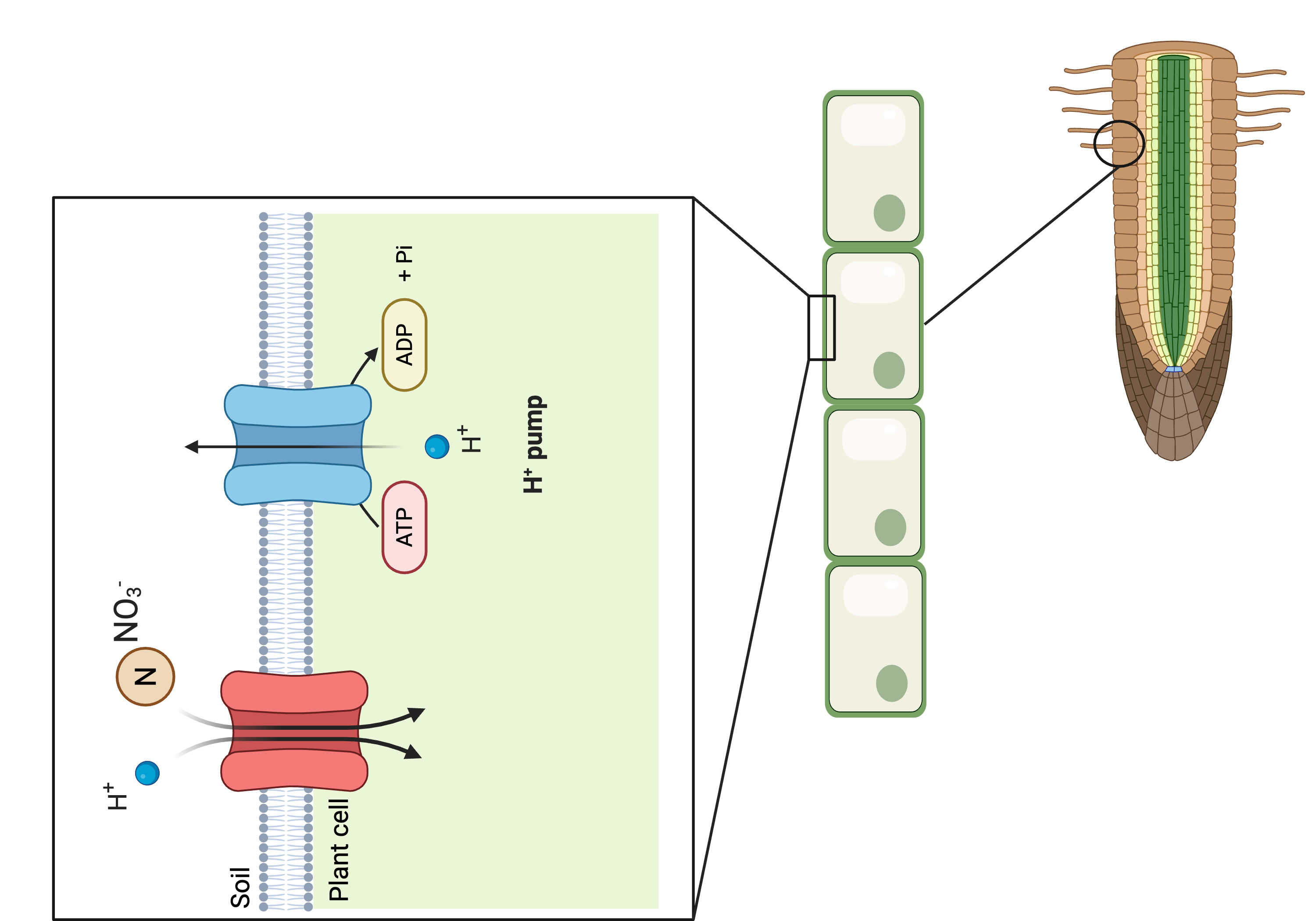5.4 Nutritional Requirements of Plants
Hannah Nelson and Christelle Sabatier
Learning Objectives
By the end of this section, you will be able to do the following:
- Describe how plants obtain nutrients.
- Describe the major elements and compounds required for proper plant nutrition.
- Describe an essential nutrients.
Plants can absorb nutrients and water through their root system, as well as carbon dioxide from the atmosphere. The combination of soil nutrients, water, and carbon dioxide, along with sunlight, allows plants to grow.
The Chemical Composition of Plants
Plants are primarily composed of carbohydrates, used as the primary source of energy and supporting structural integrity.
Plant cells need essential substances, collectively called nutrients, to sustain life. Plant nutrients may be composed of either organic or inorganic compounds. An organic compound is a chemical compound that contains carbon, such as carbohydrates, lipids, proteins, and nucleic acids and is made by a living organism. Carbon that was obtained from atmospheric CO2 is incorporated into organic molecules by plants and as such, composes the majority of the dry mass within most plants. An inorganic compound does not contain carbon (except in the form of CO2). Inorganic substances are commonly called minerals: those required by plants include nitrogen (N) and potassium (K).
Practice Questions
Essential Nutrients
Plants require only light, water, and about 20 elements to support all their biochemical needs; these 20 elements are called essential nutrients. For an element to be regarded as essential, three criteria are required: 1) a plant cannot complete its life cycle without the element; 2) no other element can perform the function of the element; and 3) the element is directly involved in plant nutrition.
Macronutrients and Micronutrients
The essential elements can be divided into two groups: macronutrients and micronutrients. Nutrients that plants require in larger amounts are called macronutrients. About half of the essential elements are considered macronutrients: carbon, hydrogen, oxygen, nitrogen, phosphorus, potassium, calcium, magnesium and sulfur. The first of these macronutrients, carbon (C), is required to form carbohydrates, proteins, nucleic acids, and many other compounds; it is therefore present in all macromolecules. On average, the dry weight (excluding water) of a cell is 45% carbon. Carbon is a key part of plant biomolecules, followed by oxygen (45%) and hydrogen (6%), which are the next two most abundant elements in plants.

Whereas carbon is obtained from the atmosphere through the process of photosynthesis, other macronutrients and micronutrients are obtained from the soil through the roots. Nitrogen in the form of nitrate (NO3–) is critical for the synthesis of amino acids and nucleotides, which make up proteins and nucleic acids found in cells throughout a plant. Phosphorus in the form of inorganic phosphate (PO43-) is important for the synthesis of nucleotides and phospholipids.
Deficiencies in any of these nutrients—particularly the macronutrients—can adversely affect plant growth (Figure 5.10). Depending on the specific nutrient, a lack can cause stunted growth, slow growth, or chlorosis (yellowing of the leaves). Extreme deficiencies may result in leaves showing signs of cell death.

Practice Questions
Check out the below video describing specific nutrient deficiencies in plants.
Video 5.4.1. Plant Nutrition | Plants | Biology | FuseSchool by FuseSchool – Global Education
The majority of volume in a plant cell is water; it typically comprises 80% to 90% of the plant’s total weight. Soil is the water source for land plants, and can be an abundant source of water, even if it appears dry. Water flow into root cells occurs through osmosis and is promoted by the active uptake of nutrients from the soil into the plants. Plant roots absorb water from the soil through root hairs and transport it up to the leaves. As water vapor is lost from the leaves, the process of transpiration and the polarity of water molecules (which enables them to form hydrogen bonds) draws more water from the roots up through the plant to the leaves (Figure 5.4.2). Plants need water to support cell structure, for metabolic functions, to carry nutrients, and for photosynthesis.

Making Connections
Dermal root cells exist at the edge between the body of a plant and the soil environment around them. They are critical to nutrient and water uptake. This function uses the principles of membrane transport that were discussed in Chapter 4.
There are 53 different genes dedicated to nitrate transport in the model plant, Arabidopsis. This is an indication of how important the uptake and regulation of nitrogen uptake is for plant growth and maintenance. One such gene, NRT2.1, is responsible for the production of a nitrate transporter in growing root tips where it is expressed alongside H+ ATPase transporter or H+ pump (Figure 5.4.4). NRT2.1 produces a nitrate/H+ cotransporter.
 Figure 5.4.4. Diagram of the nitrate/H+ cotransporter encoded by the NRT2.1 gene. (credit: created with BioRender.com) [Image Description]
Figure 5.4.4. Diagram of the nitrate/H+ cotransporter encoded by the NRT2.1 gene. (credit: created with BioRender.com) [Image Description]
Glossary
macronutrients
nutrients that plants require in large amounts (e.g. carbon, nitrogen, and phosphorus)
micronutrients
nutrients that plants require in trace amounts (e.g. iron, zinc, and copper)
Figure Descriptions
Figure 5.4.1. The graphic has two levels of detail. Across the top, three pale-green, rope-like cellulose fibers run horizontally, suggesting the bundled strands that reinforce plant cell walls. Below, a close-up cellulose structure depicts six repeating β-glucose rings drawn as hexagons that alternate orientation. Each ring bears –CH₂OH and –OH groups, and the rings are joined by oxygen bridges to form straight β-1,4 glycosidic bonds; square brackets and an “n” on the right indicate the pattern continues for many units. Together the fiber view and the molecular diagram highlight cellulose as long, unbranched chains of glucose that aggregate into strong structural fibers. [Return to Figure 5.4.1]
Figure 5.4.2. The composite image arranges four square photographs in a 2 × 2 grid, each labeled with a lowercase letter. (a) shows a grape-tomato plant; one pale green fruit hangs downward with a dark, sunken, leathery spot at its blossom end—classic blossom-end rot caused by calcium deficiency. (b) depicts a cluster of Frangula alnus (alder buckthorn) leaves in partial shade; several leaves display irregular yellow patches while their veins remain darker green, indicating magnesium deficiency. (c) focuses on a single dropped sweetgum leaf lying on soil; the veins form a bold green network while the tissue between them is yellow—a pattern called interveinal chlorosis, also linked to inadequate magnesium. (d) features a fan-shaped palm; many frond tips and outer leaflets are yellowing or browning, symptoms typical of potassium deficiency. Together, the quartet illustrates how different mineral shortages produce distinct visual cues in plant tissues. [Return to Figure 5.4.2]
Figure 5.4.3. The image illustrates a young plant with a green stem and two leaves growing from brown soil. The roots extend downward into the soil. Three separate insets depict cellular and physiological processes. The bottom-right inset displays root cells, showing the pathway of water uptake with arrows from the soil into the xylem drawn in red. The left inset depicts a cellular process of water movement in the xylem, with red and white circles representing water molecules and arrows indicating adhesion of the water to the cellulose that lines the xylem bundles.The top-right inset shows a cross-section of a leaf cell, highlighting the process of transpiration as water movement depicted by arrows moves from the xylem through the stomata and out into the atmosphere. [Return to Figure 5.4.3]
Figure 5.4.4. The image shows a detailed diagram illustrating the process of nitrogen uptake in plants. On the right is a cross-section of a plant root with root hairs, colored in various earthy tones. To the left, a close-up view depicts the plant cell membrane. Within this section, a blue proton (H+) pump and a red nitrate (NO3-) transporter are shown embedded in the membrane. The proton pump transfers H+ ions from the plant cell into the soil, converting ATP to ADP with the release of inorganic phosphate (Pi). The nitrate transporter takes up nitrate ions from the soil into the plant cell. This entire process is shown as taking place within a simplified plant cell environment, with clear lines indicating each part of the mechanism. [Return to Figure 5.4.4]
Licenses and Attributions
“5.4 Nutritional Requirements of Plants” is adapted from “31.1 Nutritional Requirements of Plants” by Mary Ann Clark, Matthew Douglas, and Jung Choi for OpenStax Biology 2e under CC-BY 4.0. “5.4 Nutritional Requirements of Plants” is licensed under CC-BY-NC 4.0.
Media Attributions
- 1A.B.cellulosestructure
- 1A.B.nutrientdefficientplants
- Transpiration_Overview.svg © Laurel Jules is licensed under a CC BY-SA (Attribution ShareAlike) license
- 1A.B.5 Nitrate Root Uptake © Christelle Sabatier is licensed under a CC BY (Attribution) license
nutrients that plants require in large amounts
nutrients that plants require in trace amounts (e.g. iron, zinc, and copper)
